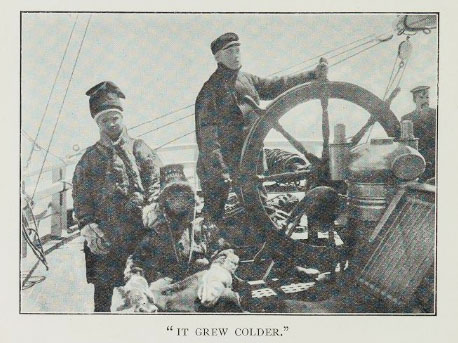|
SS Southern Cross (1886)
SS ''Southern Cross'' was a steam-powered sealing vessel that operated primarily in Norway and Newfoundland and Labrador. She was lost at sea returning from the seal hunt on March 31, 1914, killing all 174 men aboard in the same storm that killed 78 crewmen from the , a collective tragedy that became known as the "1914 Newfoundland Sealing Disaster". Background The vessel was commissioned as the whaler ''Pollux'' at Arendal, Norway in 1886, was barque-rigged, registered 520 tons gross, and was long overall. ''Pollux'' was designed by Colin Archer, the renowned Norwegian shipbuilder. Archer had designed and built Nansen's ship ''Fram,'' which in 1896 had returned unscathed from its long drift in the northern polar ocean during Nansen's "Farthest North" expedition, 1893–96. ''Pollux'' was sold to the Norwegian explorer Carsten Borchgrevink in 1897 ''and'' renamed ''Southern Cross'', for the Southern Cross Expedition. Like several of the historic polar ships her p ... [...More Info...] [...Related Items...] OR: [Wikipedia] [Google] [Baidu] |
River Derwent (Tasmania)
The River Derwent is a river located in Tasmania, Australia. It is also known by the palawa kani name timtumili minanya. The river rises in the state's Central Highlands at Lake St Clair, and descends more than over a distance of more than , flowing through Hobart, the state's capital city, before emptying into Storm Bay and flowing into the Tasman Sea. The banks of the Derwent were once covered by forests and occupied by Aboriginal Tasmanians. European settlers farmed the area and during the 20th century many dams were built on its tributaries for the generation of hydro-electricity. Agriculture, forestry, hydropower generation and fish hatcheries dominate catchment land use. The Derwent is also an important source of water for irrigation and water supply. Most of Hobart's water supply is taken from the lower River Derwent. Nearly 40% of Tasmania's population lives around the estuary's margins and the Derwent is widely used for recreation, boating, recreational fishing, m ... [...More Info...] [...Related Items...] OR: [Wikipedia] [Google] [Baidu] |
Carsten Borchgrevink
Carsten Egeberg Borchgrevink (1 December 186421 April 1934) was an Anglo-Norwegian polar explorer and a pioneer of Antarctic travel. He inspired Sir Robert Falcon Scott, Sir Ernest Shackleton, Roald Amundsen, and others associated with the Heroic Age of Antarctic Exploration. Borchgrevink began his exploring career in 1894 by joining a Norwegian whaling expedition, during which he became one of the first people to set foot on the Antarctic mainland. This achievement helped him to obtain backing for his ''Southern Cross'' expedition, which became the first to overwinter on the Antarctic mainland, and the first to visit the Great Ice Barrier since the expedition of Sir James Clark Ross nearly sixty years earlier. The expedition's successes were received with only moderate interest by the publicand by the British geographical establishment, whose attention was by then focused on Scott's upcoming ''Discovery'' expedition. Some of Borchgrevink's colleagues were critical of his lea ... [...More Info...] [...Related Items...] OR: [Wikipedia] [Google] [Baidu] |
Southern Cross (folk Song)
The song "Southern Cross" is a traditional Newfoundland folk ballad describing the loss of ''Southern Cross'' on the south coast of Newfoundland with 173 men on board. Lyrics She got up the steam twelfth day of March and shortly did embark. To try her fortune in the Gulf in charge of Captain Clark. She carried a hundred and seventy men, a strong and vigorous race, Some from St. John's and Brigus, and some more from Harbour Grace. She reached the Gulf in early March, the white-coats for to slew, When seventeen thousand prime young harps killed by her hardy crew, All panned and safely stowed below, with colours waving gay, The ''Southern Cross'' she leaved the ice, bound up for home that day. She passed near Channel homeward bound, as news came out next day, To say a steamer from the Gulf she noe is on her way. "No doubt it is the ''Southern Cross'', "the operator said, "And looking to have a bumper trip, and well down by the head." The last of March the storm came on with bl ... [...More Info...] [...Related Items...] OR: [Wikipedia] [Google] [Baidu] |
National Film Board Of Canada
The National Film Board of Canada (NFB; french: Office national du film du Canada (ONF)) is Canada's public film and digital media producer and distributor. An agency of the Government of Canada, the NFB produces and distributes documentary films, animation, web documentaries, and alternative dramas. In total, the NFB has produced over 13,000 productions since its inception, which have won over 5,000 awards. The NFB reports to the Parliament of Canada through the Minister of Canadian Heritage. It has bilingual production programs and branches in English and French, including multicultural-related documentaries. History Canadian Government Motion Picture Bureau The Exhibits and Publicity Bureau was founded on 19 September 1918, and was reorganized into the Canadian Government Motion Picture Bureau in 1923. The organization's budget stagnated and declined during the Great Depression. Frank Badgley, who served as the bureau's director from 1927 to 1941, stated that the bur ... [...More Info...] [...Related Items...] OR: [Wikipedia] [Google] [Baidu] |
Cassie Brown
Cassie Eileen Brown (January 10, 1919 – December 30, 1986) was a Newfoundland and Labrador journalist, author, publisher and editor. Brown is most distinguished for her books ''Death on the Ice'', which was featured in ''Reader's Digest'', and ''The Wreck of the Florizel''. Early life and education Brown was born in Rose Blanche, Newfoundland, to Wilson and Caroline (Hillier) Horwood. Her early education took place in Rose Blanche, St. Georges, and, later, in St. John's after her family moved there when she was eleven years old. In St. John's, Brown's father worked as a freelance broadcaster and her mother as a teacher and entrepreneur. The tourist resort, "Karwood", established by Caroline Horwood on the outskirts of St. John's, would eventually become Brown's writing retreat. Career Brown started writing when she was a teenager, beginning with newspaper articles. Later, her work expanded to include freelance script-writing and educational broadcasts for CBC. She gained re ... [...More Info...] [...Related Items...] OR: [Wikipedia] [Google] [Baidu] |
Rockwell Kent
Rockwell Kent (June 21, 1882 – March 13, 1971) was an American painter, printmaker, illustrator, writer, sailor, adventurer and voyager. Biography Rockwell Kent was born in Tarrytown, New York. Kent was of English descent. He lived much of his early life in and around New York City, where he attended the Horace Mann School. Kent studied with several influential painters and theorists of his day. He studied composition and design with Arthur Wesley Dow at the Art Students League in the fall of 1900, and he studied painting with William Merritt Chase each of the three summers between 1900 and 1902 at the Shinnecock Hills Summer School of Art, after which he entered in the fall of 1902 Robert Henri's class at the New York School of Art, which Chase had founded. During the summer of 1903, in Dublin, New Hampshire, Kent was apprenticed to painter and naturalist Abbott Handerson Thayer. An undergraduate background in architecture at Columbia University prepared Kent for occasion ... [...More Info...] [...Related Items...] OR: [Wikipedia] [Google] [Baidu] |
SS Newfoundland
SS ''Newfoundland'' was a wooden-hulled brigantine and steamship that was built in 1872 and wrecked in 1916. She was a cargo ship, and for part of her career she was a sealing ship. In 1916 she was renamed ''Samuel Blandford''. ''Newfoundland'' was involved in two disasters. The first was the 1914 Newfoundland Sealing Disaster, when 132 sealers were stranded on an ice floe, resulting in 78 deaths. The second was in 1916, shortly after she had been renamed, when she struck rocks and was wrecked. Specifications Peter Baldwin built ''Newfoundland'' in Quebec, completing her in 1872. Her registered length was , her beam was , her depth was and her tonnages were and . She had two masts and was rigged as a brigantine. ''Newfoundland'' had a two-cylinder compound steam engine, built by the Ouseburn Engine Works of Newcastle upon Tyne, England, which powered her single screw. It was originally rated at "130 HP", but by 1903 it was rated at 162 NHP. Owners, managers and registr ... [...More Info...] [...Related Items...] OR: [Wikipedia] [Google] [Baidu] |
Clements Markham
Sir Clements Robert Markham (20 July 1830 – 30 January 1916) was an English geographer, explorer and writer. He was secretary of the Royal Geographical Society (RGS) between 1863 and 1888, and later served as the Society's president for a further 12 years. In the latter capacity he was mainly responsible for organising the British National Antarctic Expedition of 1901–1904, and for launching the polar career of Robert Falcon Scott. Markham began his career as a Royal Navy cadet and midshipman, during which time he went to the Arctic with in one of the many searches for Franklin's lost expedition. Later, Markham served as a geographer to the India Office, and was responsible for the collection of cinchona plants from their native Peruvian forests, and their transplantation in India. By this means, the Indian government acquired a home source from which quinine could be extracted. Markham also served as geographer to Sir Robert Napier, 1st Baron Napier of Magdala, ... [...More Info...] [...Related Items...] OR: [Wikipedia] [Google] [Baidu] |
Ross Sea
The Ross Sea is a deep bay of the Southern Ocean in Antarctica, between Victoria Land and Marie Byrd Land and within the Ross Embayment, and is the southernmost sea on Earth. It derives its name from the British explorer James Clark Ross who visited this area in 1841. To the west of the sea lies Ross Island and Victoria Land, to the east Roosevelt Island and Edward VII Peninsula in Marie Byrd Land, while the southernmost part is covered by the Ross Ice Shelf, and is about from the South Pole. Its boundaries and area have been defined by the New Zealand National Institute of Water and Atmospheric Research as having an area of . The circulation of the Ross Sea is dominated by a wind-driven ocean gyre and the flow is strongly influenced by three submarine ridges that run from southwest to northeast. The circumpolar deep water current is a relatively warm, salty and nutrient-rich water mass that flows onto the continental shelf at certain locations. The Ross Sea is covered wit ... [...More Info...] [...Related Items...] OR: [Wikipedia] [Google] [Baidu] |
Larvik
Larvik () is a town and municipality in Vestfold in Vestfold og Telemark county, Norway. The administrative centre of the municipality is the city of Larvik. The municipality of Larvik has about 46,364 inhabitants. The municipality has a 110 km coastline, only shorter than that of neighbouring Sandefjord. The city achieved market town status in 1671. Larvik was established as a municipality on 1 January 1838 (see formannskapsdistrikt). The city of Stavern, and the rural municipalities of Brunlanes, Hedrum, and Tjølling were forcefully merged into the municipality of Larvik on 1 January 1988. On 1 January 2018, neighboring Lardal was merged into Larvik as part of a nationwide municipal reform. After the merge, Larvik is the largest municipality in Vestfold by area, and the second-most populous municipality in the Vestfold district. Larvik is known as the hometown of Thor Heyerdahl. It is also home to ''Bøkeskogen'', the northernmost beech tree forest in the world. It is als ... [...More Info...] [...Related Items...] OR: [Wikipedia] [Google] [Baidu] |






.jpg)
.jpg)